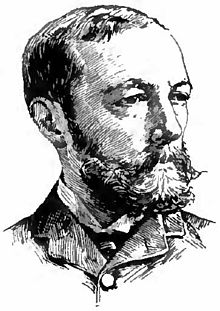Arnold Hague
Arnold Hague (born December 3, 1840 in Boston , Massachusetts , † May 14, 1917 in Washington, DC ) was an American geologist .
Life
education
The son of a pastor and younger brother of James Duncan Hague (1826-1908) studied during the American Civil War (he had volunteered, but had not been accepted for physical reasons) at Yale University (Sheffield Scientific School) science and special Graduated from 1863 in chemistry, geology (with James Dwight Dana ), and mining. His (older) fellow students at Sheffield Scientific College included Clarence King (whom he became friends with), Josiah Willard Gibbs, and Othniel Charles Marsh . He then continued his studies for three years in Germany - in Göttingen(Learning the German language), Heidelberg (in Robert Bunsen's laboratory ) and at the Bergakademie Freiberg - continued. From Bunsen he probably already had the idea of dividing volcanic rocks into pyroxenic magmas ( basalt ), trachytic magmas (containing feldspar) and mixtures of these (this was included in his later discussion of volcanism in Nevada). During this time he tried to volunteer for military service several times, but was always rejected, most recently shortly before the end of the war in a personal letter from Abraham Lincoln himself. In 1865 he went to the Bergakademie Freiburg, where he first met Samuel F. Emmons , the had already studied there for a year and with whom he also became friends. In Freiburg he learned geological mapping and petrography based on the textbook of his teacher there, Bernhard von Cotta .
Professional activities
After returning in 1867, he took part in the state exploration mission across the USA at the 40th parallel (Geological Exploration of the Fortieth Parallel) across the Cordilleras of the American West under the chief geologist Clarence King and with Emmons as a further assistant (was there a transcontinental railway line planned). He was in California and Nevada, examined the Comstock Lode silver mine and the amalgamation process (Washoe process) used there for silver extraction. With Samuel F. Emmons, he mapped the Great Basin in Utah and Nevada, which at that time required great strains before the corresponding transcontinental railroad lines were expanded.
In 1877 he became a state geologist in Guatemala , where he studied volcanoes and mineral resources, and in 1878 he investigated mineral resources (silver, gold, lead) in northern China on behalf of the Chinese government. When the US Geological Survey was founded in 1879, he was one of the geologists employed there and examined Eureka County in Nevada. In 1883 he became the geologist responsible for the area of Yellowstone Park , where he examined the geysers , among other things .
Memberships and honors
In 1885 he became a member of the National Academy of Sciences and in 1903 the American Philosophical Society . He was an honorary doctor from Columbia University and the University of Aberdeen . In 1900 he was Vice-President of the International Geological Congress in Paris, in 1910 in Stockholm and in 1913 in Toronto . In 1910 he became president of the Geological Society of America .
Fonts
- with Emmons: Descriptive Geology , in Reports of the Exploration of the Fortieth Parallel, Volume 2, Washington, DC 1877
- The Volcanoes of California, Oregon, and Washington Territory , 1883
- The Volcanic Rocks of the Great Basin 1884
- On the Development of Crystallization in the Igneous Rocks of Washoe 1885
- Nevada, with Notes on the Geology of the District , 1885
- The Volcanic Rocks of Salvador , 1886
literature
- Hague, William . In: James Grant Wilson, John Fiske (Eds.): Appletons' Cyclopædia of American Biography . tape 3 : Grinnell - Lockwood . D. Appleton and Company, New York 1887, p. 26 (English, full text [ Wikisource ]).
Web links
- Joseph Iddings, Biographical Memoirs National Academy, 1919 (PDF; 1.4 MB; English)
- Literature by and about Arnold Hague in the WorldCat bibliographic database
References and comments
- ↑ The mother was with the mathematician Bowditch Nathaniel related
- ↑ However, later modified in Bernhard von Cotta's representation of the division into basic and acidic magmas (vulcanites and plutonites in each case) according to a silicon-rich crust (acidic part) that floats on a basic liquid.
- ^ Member History: Arnold Hague. American Philosophical Society, accessed September 19, 2018 .
| personal data | |
|---|---|
| SURNAME | Hague, Arnold |
| BRIEF DESCRIPTION | American geologist |
| DATE OF BIRTH | December 3, 1840 |
| PLACE OF BIRTH | Boston , Massachusetts |
| DATE OF DEATH | May 14, 1917 |
| Place of death | Washington, DC |

